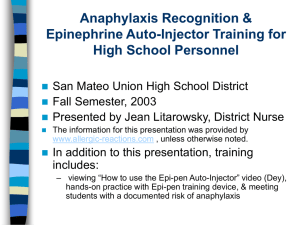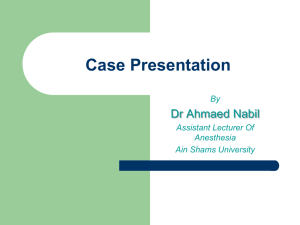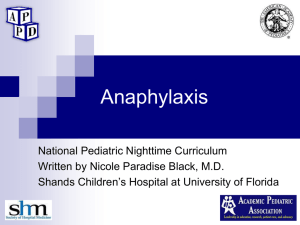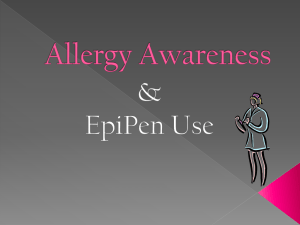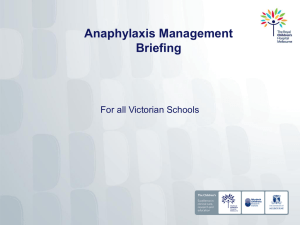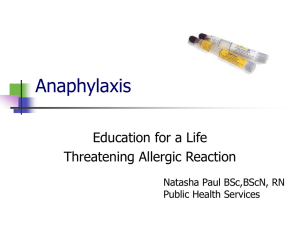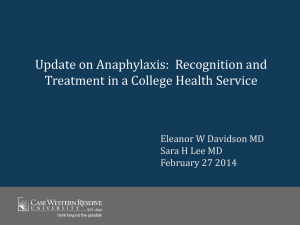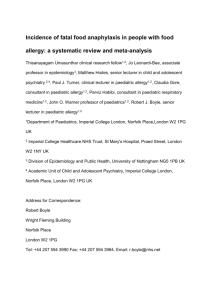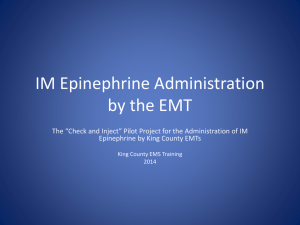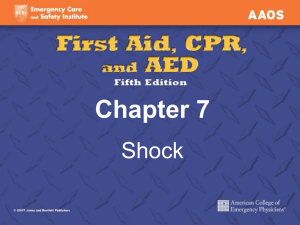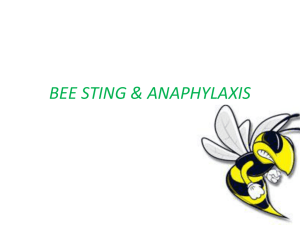Gadolinium and Contrast Media Reaction November 2013
advertisement
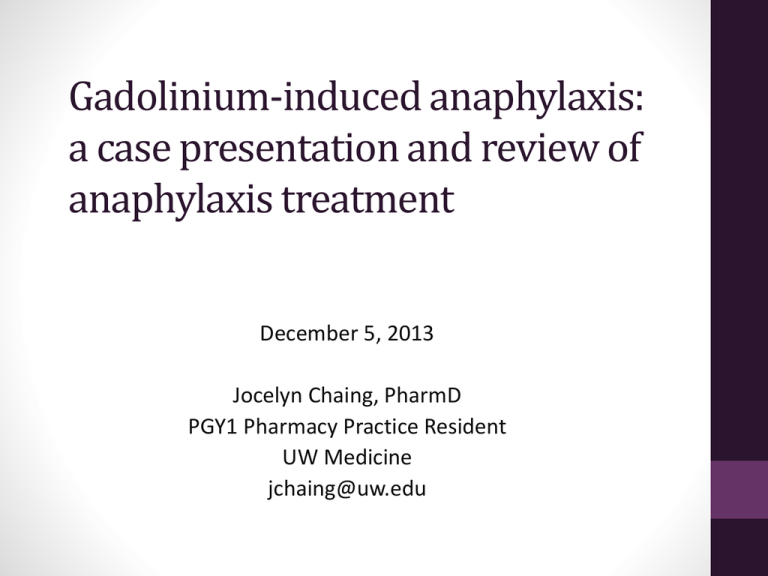
Gadolinium-induced anaphylaxis: a case presentation and review of anaphylaxis treatment December 5, 2013 Jocelyn Chaing, PharmD PGY1 Pharmacy Practice Resident UW Medicine jchaing@uw.edu Case • 31 y/o F presents to UWMC for outpatient MRI of abdomen • Past Medical History • Crohn’s disease • s/p 2 colectomies • Allergies • Gadolinium containing compounds • Iodinated radiocontrast dye • Medications • Folate • Methotrexate • Effexor Case (continued) • Patient’s History • In 2009 – pt had an anaphylactic rxn to iodinated radiocontrast • In 2010 – pt had an anaphylactic reaction gadolinium • In 2012- pt tolerated an MR enterography with pretreatment steroids and antihistamine prior to gadolinium injection • GI recommended pretreatment with methylprednisolone PO 32 mg 12 hours and 2 hours prior to MRI as well as diphenhydramine 50 mg PO 1 hr before the gadolinium injection Case (continued) Pt was scheduled for an MRI for staging of her Crohn’s Disease • Minutes after administration of gadolinium contrast, the pt began sneezing and coughing • Radiology tech observes the pt is tachypneic w/ labored breathing and has signs of cyanosis • Immediately, the pt is wheeled across the hall into the ER Case (continued) • Vital signs the ED: • • • • • Temp 36.0°C HR 136 RR 31 BP 98/57 mmHg O2 Sat 77% on room air • Physical Exam • • • • Positive for cyanosis Red rash on stomach Somnolent Diffuse expiratory wheezing • Swollen oropharynx Diagnosis UpToDate Hypersensitivity Reactions • Gell and Coombs Classification Type Classification Mechanism I Anaphylactic hypersensitivity IgE II Cytotoxic hypersensitivity Cytotoxic Ab (IgM, IgG) III Immune complex hypersensitivity IgG IV Delayed-type hypersensitivity Cell-mediated (lymphocytes) UpToDate Anaphylaxis • 50 to 2,000 episodes per 100,000 people in the U.S. • 1,500 deaths per year • Type I Hypersensitivity • Immunologic reaction to foods, drugs, insect stings • Onset: seconds to 1 hr • Ranges from mild to lifethreatening Kemp SF, Lockey RF. Anaphylaxis: a review of causes and mechanisms. J Allergy Clin Immunol 2002;110:341–348 Clinical Presentation • Signs and symptoms (% of anaphylactic episodes) • Skin (90%) – urticaria, angioedema, pruritis, flushing • Respiratory (70%) – dyspnea, throat tightness, stridor, wheezing, rhinorrhea, hoarseness, and cough • GI (45%) – nausea, vomiting, abdominal cramping, diarrhea • Cardiovascular (45%) – hypotension, tachycardia, syncope • Deaths mainly due to respiratory distress or cardiovascular collapse Kemp SF, Lockey RF. Anaphylaxis: a review of causes and mechanisms. J Allergy Clin Immunol 2002;110:341– 348 Time course • Uniphasic anaphylaxis • Most common, 80% of all anaphylactic reactions • Response peaks 30-60 min • Symptoms resolve spontaneously or w/ treatment within 3060 min • Biphasic anaphylaxis • 20% of all anaphylactic reactions • Uniphasic response followed by an asymptomatic period of >1 hr and recrudescence of symptoms without further exposure to the antigen • Protracted anaphylaxis • Uncommon • Lasts hours to days UpToDate Pathophysiology Biochemical Mediators in Anaphylaxis Biochemical Roles Histamine H1 receptors – pruritis, rhinorrhea, tachycardia, bronchospasm H1 and H2 receptors – headache, flushing, hypotension Prostaglandin D2 Bronchospasm, vascular dilatation Leukotriene D4 and E4 Hypotension, bronchospasm, mucous secretion, chemotactic signals for eosinophils and neutroophils T-Helper 1 Cellular immunity; produce interferon gamma T-Helper 2 Humoral immunity; produce cytokines (interleukin) Kemp SF, Lockey RF. Anaphylaxis: a review of causes and mechanisms. J Allergy Clin Immunol 2002;110:341–348 Anaphylactic vs. Anaphylactoid • Anaphylactic reactions • IgE mediated • Occurs after re-exposure to antigen • Examples: antibiotics, peanuts, insect venom • Anaphylactoid reactions • Identical pathophysiology as anaphylactic reactions, but NOT IgE mediated • Can occur after first exposure to antigen • Example: radiocontrast media Treatment of Anaphylaxis • • • • • • Epinephrine Maintain airway Supplemental oxygen IV fluids if pt is hypotensive Consider adjunctive agents Monitor vitals and pulse oximetry for 4-10 hrs • Identify antigen and avoid future exposure Epinephrine • First line agent in all cases of anaphylaxis • Adult Dose • 0.3-0.5 mg IM x 1, may repeat q515min prn • 0.3-0.5 mL of epinephrine 1:1000* (1 mg/mL) solution • No absolute contraindications in the setting of anaphylaxis • Onset: rapid *NOTE CONCENTRATION Johnson RF and Stokes Peebles R. Anaphylactic Shock: Pathophysiology, Recognition, and Treatment. Seminars in Respiratory and Critical Care Medicine. 2004:25(6);695-703. Epinephrine • Prevent/reverse airway obstruction and CV collapse • Mechanism of action • Alpha-1 adrenergic agonist - vasoconstriction, systemic vascular resistance, mucosal edema in upper airway • Beta-1 adrenergic agonist - ionotropy, chronotropy • Beta-2 adrenergic agonist - bronchodilation, release of mediators from mast cells and basophils • Monitor: BP, HR • Adverse effects: anxiety, flushing, pallor, hypertension, palpitations, angina, arrhythmias, intracranial hemorrhage Simons et al. World Allergy Organization Guidelines for Assessment and Management of Anaphylaxis. WAO Position Paper 2011:1-37. Epinephrine • IM vs. SQ vs. IV • Simons et al reported epinephrine IM is superior to SQ • Delayed epinephrine absorption with SQ compared with IM • Due to the cutaneous vasoconstrictive properties of epinephrine • Deltoid vs. Vastus lateralis (thigh) • Simons et al reported superior serum levels of epinephrine in thigh compared to SQ and IM into the deltoid • Superiority of blood flow to the vastus lateralis Simons et al. Epinephrine absorption in children with a history of anaphylaxis. J Allergy Clin Immunol 1998;101:33–37 Simons et al. Epinephrine absorption in adults: intramuscular versus subcutaneous injection. J Allergy Clin Immunol 2001;108:871–873 Adjunctive Agents • Do NOT substitute for epinephrine IM • No randomized double-blind, placebo-controlled trials of any of these medications in the treatment of acute anaphylaxis episodes • Doses are extrapolated from use in treatment of other disease states Simons FER. Anaphylaxis: evidence-based long-term risk reduction in the community. Immunol Allergy Clin North Am 2007;27:231-48. Albuterol • Dose: 1 Albuterol 0.083% ampule (2.5 mL) via nebulizer q15min • Onset: 5-10 minutes • Treats bronchospasm • Mechanism of action • Beta-2 agonist – bronchodilation • Monitor: HR • Adverse effects: palpitations, tachycardia, cardiac arrhythmias Simons et al. World Allergy Organization Guidelines for Assessment and Management of Anaphylaxis. WAO Position Paper 2011:1-37. Diphenhydramine • • • • • Adjunctive agent Dose: 25-50 mg IV, may repeat until MAX 400mg/24hr Onset: 15-60 min (oral), unknown for IV Treats itching and urticaria Mechanism of action • H1 receptor antagonist – blocks histamine effects on H1 receptors of effector cells in GI, blood vessels, and respiratory tract • Adverse effects: somnolence, hypotension Simons et al. World Allergy Organization Guidelines for Assessment and Management of Anaphylaxis. WAO Position Paper 2011:1-37. Ranitidine • Dose: 50 mg IVPB x 1 • Treats hypotension in conjunction with H1 antihistamines • Minimal evidence to support use w/ H1 antihistamines • Onset: 1 hour • Mechanism of action • H2 receptor antagonist - blocks histamine effects on H2 receptors of effector cells • Both H1 and H2 receptors mediate headache, flushing, and hypotension • Adverse Effects: less sedation than H1 antihistamines, transient local burning or itching with IV administration Simons et al. World Allergy Organization Guidelines for Assessment and Management of Anaphylaxis. WAO Position Paper 2011:1-37. Glucocorticoid • • • • • Prevent biphasic or protracted reactions Limited evidence to support effectiveness if anaphylaxis Dose: methylprednisolone 1-2 mg/kg/day IV Onset: 30 minutes Mechanism of action • Decreased formation, release and activity of the mediators of inflammation • Adverse Effects: fluid retention, cushing’s, hyperglycemia, impaired wound healing Simons et al. World Allergy Organization Guidelines for Assessment and Management of Anaphylaxis. WAO Position Paper 2011:1-37. Case (continued) • Pt showing signs of anaphylactic shock • Anesthesia and ENT paged for possible intubation • Pt Immediately received: • • • • Epinephrine 0.3 mg IM x 1 Diphenhydramine 50 mg IV x 1 Methylprednisolone 125 mg IV x 1 Ranitidine 50 mg IVPB x 1 • Vitals signs • • • • HR 121 BP 106/71 mmHg O2 saturation 99% with Vent Face Mask Patient more alert and reports feeling better Case (continued) 10 minutes later: • RN reports pt is having labored breathing and chest tightness • Vital signs: • HR 135 • RR 26 • O2 saturation 98% with Vent Face Mask What is going on? Refractory Anaphylaxis • Patients who do not respond to epinephrine IM • Biphasic or protracted anaphylaxis • Pathophysiology unknown • Possible saturation/desensitization of adrenergic receptors • Possible prolonged half-life of offending antigen • No published prospective studies on the optimal management of refractory anaphylaxis • Treatment options: • Maintain airway • Epinephrine • Glucagon Kemp SF, Lockey RF. Anaphylaxis: a review of causes and mechanisms. J Allergy Clin Immunol 2002;110:341–348 Epinephrine infusion • For patient with profound hypotension or signs of shock • Initial dose: 2-10 mcg/min • Alaris pumps in mcg/kg/min • Maintain SBP >90 mmHg, MAP>60 • Requires close monitoring (HR, BP) • Adverse effects: ventricular arrhythmias, hypertensive crisis, pulmonary edema • Consider pt’s IV access • Peripheral vs. Central Johnson RF and Stokes Peebles R. Anaphylactic Shock: Pathophysiology, Recognition, and Treatment. Seminars in Respiratory and Critical Care Medicine. 2004:25(6);695-703. Glucagon • Patients taking beta-blockers have more severe or treatmentrefractory anaphylaxis • Dose: 1 mg IV q5min, then 5 -15 mcg/min IV infusion • Increase HR and cardiac output • Mechanism • Non-adrenergic pathway • Stimulate adenylate cyclase to produce cyclic AMP (calciumdependent stimulation) • Positive ionotropic and chronotropic effects • Adverse Effects: nausea, vomiting Johnson RF and Stokes Peebles R. Anaphylactic Shock: Pathophysiology, Recognition, and Treatment. Seminars in Respiratory and Critical Care Medicine. 2004:25(6);695-703. Case (continued) • Pt started on epinephrine infusion • Initial dose 0.02 mcg/kg/min • Translates to 1.1 mcg/min, pt does not have a central line • Wt: 55 kg • Follow up vitals: • • • • • • • • HR 108 RR 14 BP 114/71 mmHg O2 saturation 100% with 4L of O2 Intubation was not required Pt was admitted to MICU for close monitoring Epinephrine was weaned off after a few hours Pt’s course was unremarkable thereafter and discharged home Anaphylactoid Reactions from Gadolinium • MR contrast considered safe alternative to CT contrast allergy • Incidence 0.079% of 141, 623 doses • Prince et al’s restrospective analysis • Abdominal MRI highest rate of adverse events 0.013% vs. brain 0.0045% vs. spine 0.0034% (p<0.001) • Adverse events more likely in women (3.3 female to male ratio) and pt w/ history of prior allergic reactions Jung et al. Immediate hypersensitivity reaction to gadolinium-based MR contrast media. Radiology 2012 Aug;264(2)414-22. Prince et al. Incidence of immediate gadolinium contrast media reactions. AJR Feb 2011:196; 138-43. Pretreatment • Patient risk stratification (see handout) • Data supporting the use of premedication in patients with a history of allergic reactions are lacking • Many pharmacologic regimens based on observation data • Premedication Regimens at HMC/UWMC • Routine: Methylprednisolone 32 mg PO 12 hr and 2 hr before contrast injection OR prednisone 50 mg PO at 13, 7, 1 hr before contrast injection • Optional: diphenhydramine 25 mg PO 1 hr before contrast • Emergency (pt NPO): Hydrocortisone 200 mg IV or 40 mg SoluMedrol at 6 hr and 2 hr before contrast study and diphenhydramine 50 mg IV 1 hr before contrast study Pretreatment Systematic Review of 9 studies by Tramèr et al. Tramèr et al. Pharmacological prevention of serious anaphylactic reactions due to iodinated contrast media: systematic review, BMJ 2006;333:675 Pretreatment • Tramèr et al conclusions: • Incidence of respiratory and hemodynamic symptoms reduced from 0.9% to 0.2% with premedication • Need to premedicate 100-150 patients to prevent one potentially serious reaction • Usefulness of premedication prior to contrast is doubtful • Despite pretreatment with steroids, patients still have breakthrough anaphylactoid reaction • Physicians should not rely on the efficacy of premedication Conclusion • Immediate hypersensitivity to contrast media are non-IgE mediated anaphylactoid reactions • Treatment for anaphylaxis and anaphylactoid reactions are similar • Epinephrine IM is 1st line agent for all anaphylaxis and anaphylactoid reactions • Adjunctive agents should NOT replace epinephrine IM • Breakthrough reactions can occur despite pretreatment with steroids and antihistamines • Epinephrine and glucagon infusions can be used for refractory anaphylaxis Questions
